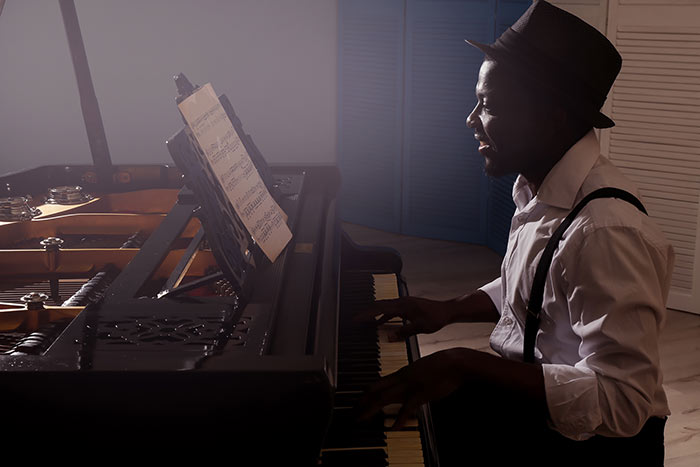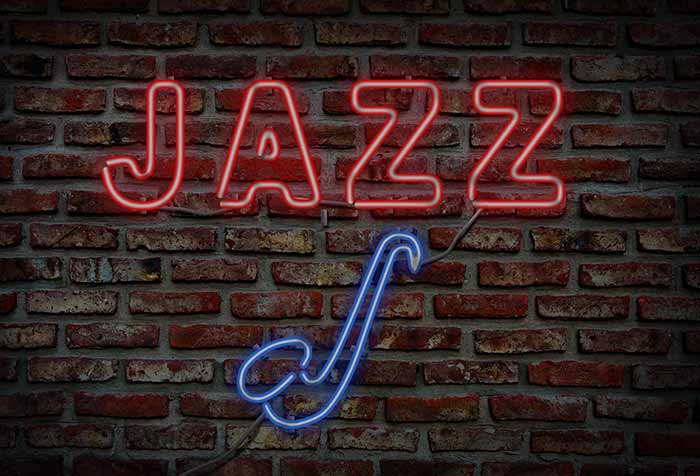Discover how to get started with jazz piano as an adult. In this article, you will get a much deeper understanding of how jazz works!
Learning to play jazz piano as an adult is one of the most rewarding things you can do!
It is, however, important that you understand the process of getting started with jazz piano.
Jazz piano is not easy to master, it requires a lot of practice and self-discipline.
It can be downright arduous at times, but the rewards are humongous once you get it right!
In this article, I will do my utmost to help you understand the journey and process of learning to play jazz piano as an adult.

Learning to play jazz piano requires a lot of memorisation
To become proficient at playing jazz piano, you need a working command of voicings, melodic lines as well as the concept of superimposition.
All these elements require a tremendous amount of actual memorisation.
Memorisation takes time.
Therefore, it will definitely help to think of learning jazz piano in terms of an exciting journey rather than a destination.
You cannot really speed up the process too much.
The reason for this, is you need to know your chords or voicings inside-out and be able to use them in a real “live” situation on the spot.
It is not simply a situation of cramming for an exam the night prior. (See the spacing effect on Wikipedia for why learning is greater when spread out over time.)
Your knowledge of jazz voicings, lines and superimposition need to be embedded in your deep long-term memory and ready to be used at will.
At The London Piano Institute, we help all our jazz students by constant (fun) drills and practice to recall important voicings, lines and superimposition.
Unfortunately (and fortunately!), there is no quick method here.
Memorisation tricks go so far, but will not help you perform at will and creatively in a “live” situation.
The greatest secret here, is to enjoy the journey!

Excellent tuition makes it so much easier
There is absolutely no doubt, that great jazz education will help you achieve your goals much quicker than self-study.
You may not be able to practice 10-12 hours a day in the likes of John Coltrane and that is why you need someone to help you get there!
As an adult learning to play jazz, five sessions of 30 to 60 minutes are all that is needed at the first steps of learning. (Along with an hour of quality jazz tuition or more weekly.)
Once you get the fire of jazz in your belly, and you have the time, you can up your practice time to 90 minutes plus per day!
Jazz may be an arduous style to learn but with dedication, it can be done!
So make sure you get excellent tuition – it is really the first step to your jazz success!
We offer students jazz tuition in the City and Mayfair in central London. Find out about our in-house courses here.
Alternatively, you can also explore online jazz Skype piano lessons from anywhere in the world with us.
Even if you do not study with us, find someone great to help you, and stick with a great teacher for at least five years!
That will really help you improve!

Listening to great jazz with intent will help you get the “jazz feel”!
Whenever a student asks me what is the first step to learning jazz, I always reply: listen, listen, listen.
By immersing yourself in jazz music, you will get a “feel” for jazz!
It is also important to note that listening only to jazz piano is not advised.
Make sure you listen to jazz that features a saxophone, guitar or a voice. (Or any instrument for that matter!)
You want to immerse yourself in the language of jazz playing as a whole.
So listen to lots of different types of jazz.
Listen to jazz played on a vibraphone. Gary Burton is the master of this style!
Or even jazz harp and harpsichord – see: https://www.youtube.com/watch?v=5gspuW2X_dw
It is amazing what is possible if you search and listen!
Make sure you listen to lots and lots of jazz!
In fact, during my University years when I studied jazz, I made a point of ONLY listening to jazz during my first year of studies.
I desperately needed to get acquainted with the style in order to excel with my studies.
Growing up I listened to classical music and rock…
Jazz is rhythmically the polar opposite of these styles and that is why you need to listen, listen and listen some more!
So take out your favourite device and create a repertoire of jazz to listen to!

Improvisation requires a complete understanding of chords, progressions and how to play through them!
Learning to improvise is definitely a wonderful experience.
In the early days, you should look at the blues scale as well as the pentatonic scale and start with easy improvisation.
As your experience grows, move to more intricate harmonic movements and expand your knowledge.
Learning how to improvise well, requires a complete understanding of harmony, melody and how they interact.
At a master level, you basically become a composer on the spot!
That means you need to have a very large selection of melodic devices and options at your disposal in order to create melodies on the spot.
That is why it is difficult!
Doable? Absolutely, but it requires time, effort and application!

Comping is the art of jazz accompaniment
The art of accompaniment in jazz, is an aspect of jazz performance that is difficult to master.
When we first learn how to play an instrument, we usually focus on being heard and on the art of improvisation.
When you accompany others in a jazz setting, your role as a jazz pianist is to very subtly provide a solid harmonic and rhythmic background for others to solo over.
This requires humility, teamwork and a willingness to let others shine!
When you comp (accompany) in jazz, the secret is to make the soloist or singer sound great.
You need to really listen to their improvisation or singing and then accompany accordingly.
You should make it easy for them to improvise or to sing or play the melody.
Your role here is to provide a solid back end – your role is to support!
The best way to learn about jazz comping (accompaniment), is to listen to great jazz playing.
Count Basie was one of the greatest jazz pianists and leaders in big band jazz.
Did you know he was initially a drummer?
I would highly recommend listening to a lot of Count Basie in order to get an understanding of how to comp sparsely. (His rhythmic and timing abilities are uncanny!)
You can also listen to Herbie Hancock and McCoy Tyner, as they both have a more aggressive style of accompaniment.
You can learn a tremendous amount by listening to both spares and aggressive styles of accompaniment.
Remember jazz is an individual art.
No two jazz players are alike.
Each jazz artist will have his or her own flavour of accompaniment.
In the early days of your jazz education, I would recommend copying the greats and incorporating their ideas into your own playing.
Of course, as an adult jazz piano student, listening to a lot of jazz is the best course of action!
You will find accompaniment and the art of comping very difficult in the early days.
That is why I recommend listening again and again.
By listening, you will develop your ear and learn the art of comping!
Once you have developed a feel for comping, then you can try it out at the piano!
Success comes to those who persevere!

Structure and form are everything in jazz!
In one sense, jazz is very simplistic.
In another sense, it is very complex…
If we take the jazz standard “All the things you are” as an example, we note the following:
- The composition is 32 bars in length
- The chord structure is based on the cycle of fourths
- The form is AABA with the last A being a variation
- The entire composition is a series of II V Is (to a large degree)
- The composition follows the classic – I IV VII III VI II V I cycle! (The first five bars: VI II V I IV)
The usual practice is to play the melody and then take turns soloing over the form of the song.
The harmonic structure stays exactly the same, the form stays exactly the same. (Throughout multiple solos)
As each instrumentalist gets a chance to improvise, nothing changes in terms of structure and form.
So from a structural point of view, jazz is super easy. (We do not change the harmony on the second, third, fourth etc… time around!)
Of course, to improvise successfully over the changes, and make beautiful music is really not easy at all!
That is the challenge or game of jazz.
You have a set structure, and you have to improvise over the underlying harmonic changes.
In addition, during a live performance, it is easy to lose your place in the structure.
That is why form and structure are everything in jazz.
You need a perfect roadmap of the composition inside your mind’s eye at all times!

Five steps to getting started!
Step 1: Listen to jazz
By listening to jazz you are attuning yourself to the sound and feel of jazz.
As a budding jazz piano student, you need to immerse yourself in the language and the culture of jazz.
I would recommend listening to jazz whilst studying the history of jazz.
There is a book by Ted Gioia called “The History of Jazz”. You can purchase that book on Amazon here.
Listen to jazz starting with ragtime and the blues.
After that you can listen to the early 1910s, combining earlier brass-band marches, French quadrilles, biguine, ragtime and blues with collective polyphonic improvisation.
Listen to Dixieland jazz.
Then listen to big-band and swing jazz.
Make sure you listen to Duke Ellington – he was and is a major influence on jazz!
Finally, you can get familiar with what we call “musician’s music” in jazz – Bebop.
Bebop is a musical style that is actually more of an art form than a commercial genre.
As a bebop musician, you can showcase your musical talents and improvisational abilities without compromise. In bebop, you do not need to only “play for the audience”!
From the 1950s onwards, jazz musicians also expanded harmonic possibilities.
Listen especially to Bill Evans amongst others.
Eventually, jazz moved to modality and finally, it moved to free jazz.
Free jazz is an avant-garde form of jazz.
Listen to Ornette Coleman
Listen to Sun Ra.
You may not like avant-garde jazz, but do listen to all styles of jazz in order to immerse yourself in the process of learning jazz!
I would recommend taking 15 minutes each day to just listen to jazz! (As part and parcel of your practice regime!)
Step 2: Take good quality jazz piano lessons
Taking jazz piano lessons with an excellent jazz piano teacher is the quickest way to learn how to play jazz!
By studying with a jazz instructor who knows all the ins and outs of jazz, you will make much faster progress than learning by yourself.
At The London Piano Institute, we have world-class jazz piano instructors who specialise in helping adults to learn jazz.
The good news is – you do not need any prior experience.
You also do not need to study classical music prior to starting jazz.
You can start as a total beginner, and learn the intricacies as well as the simplicities of this beautiful language.
In fact, you can also learn jazz piano with us from anywhere in the world. (Provided you have a reasonable internet connection!)
We provide jazz piano lessons globally via Zoom, Skype and Facetime.
The greatest thing about learning to play jazz with a top-notch instructor is that you feel supported.
You feel that someone is there for you every step of the way!
(In contrast, learning jazz by yourself is like stumbling in the dark… it is not fun and it’s not easy!)
When you study jazz piano with an expert, then you can expect results and make fast progress!
You can find out more about our jazz piano courses here.
Step 3: Learn jazz cycles
Everything in jazz is based on cycles.
Become a master of the I IV VII III VI II V I progression and you master jazz!
You see, jazz is quite predictable!
Jazz is actually easy, once you get the mechanics sorted!
Yes, making beautiful music takes lots of wisdom, time and experience.
It is not really complex.
But you do need a working understanding of chords, arpeggios and scales and how they relate over and across the different harmonic cycles.
Master the cycles and you master jazz! (Eventually!)
Step 4: Get to know the blues
The blues is a predecessor to jazz.
Blues and jazz have lots in common.
As a jazz player, you need to understand blues.
In my opinion, learning to play blues is a lot easier than learning to play jazz.
It is probably wise to start with the C Blues Scale.
The notes are: C Eb F Gb G Bb (Fingering: 1234 13 for the right-hand)
In the left hand play a simple blues tritone: E and Bb (Play the notes at the same time, and make sure it is not too muddy or too low on the piano!)
You can then play that simple tritone (representing the chord C Dominant 7 or C E G Bb) and improvise using the C Blues Scale.
Do not worry about sounding fantastic, just give it a go.
If you give it a go, you will get a little closer to what it feels like to improvise!
Small baby steps, in the beginning, is the key to becoming better!
Do not expect miracles or overnight success….
Stick at it, follow your teacher and do your daily practice!
Remember, only practice on the days that you eat!
Step 5: Make the standards your best friends!
Once you have made some progress in your jazz playing then it is time to get to know the standards.
Jazz standards are made up of a compilation of famous show tunes (and other tunes) that have become “standards” in jazz repertoire over decades.
You should find the I VI VIII III VI II V I cycle prominent throughout a lot of jazz standards.
I recommend buying the following book: The Hal Leonard Real Jazz Standards Fake Book: C Edition
According to Amazon:
This second edition features a magnificent compilation of over 250 standards of jazz repertoire in new easy-to-read authentic hand-written jazz engravings, including: Ain’t Misbehavin’ * Angel Eyes * Bein’ Green * Blue Skies * Brazil * Crazy He Calls Me * Desafinado (Off Key) * Fever * Good Morning Heartache * Here’s That Rainy Day * How High the Moon * I Can’t Give You Anything but Love * I Got It Bad and That Ain’t Good * I’ll Be Around * I’m Beginning to See the Light * I’ve Grown Accustomed to Her Face * Imagination * It Don’t Mean a Thing (If It Ain’t Got That Swing) * It’s Only a Paper Moon * Just in Time * Lazy River * Midnight Sun * My Favorite Things * My Funny Valentine * Mood Indigo * Moonglow * Moon River * Old Devil Moon * People * Route 66 * Satin Doll * Sophisticated Lady * Speak Low * Star Dust * There Is No Greater Love * When Sunny Gets Blue * Witchcraft * and more.
They are basically over 250 songs in the book.
Of course, when learning you do not need to get to know 250 tunes!
But you do need to get familiar with some of the most famous jazz standards such as:
– How High the Moon
– Ain’t Misbehavin’
– My Funny Valentine
– Here’s That Rainy Day
– Autumn Leaves
– Speak Low
– All the Things You Are
– The Girl From Ipanema
Once you master the tools of the jazz trade, then it is time to apply the concepts over the tunes!
As you can see, learning to play jazz is a tremendous amount of hard work.
The secret is approaching it as a fascinating journey!
Take the first step and the rest will follow!
Make sure you learn how to play jazz with an excellent instructor!
Once again you can find details about what we provide here.
I would like to remind you again – listen listen listen – jazz is all about developing your ear and getting an understanding of the structure and form of the particular repertoire in question.
I wish you the greatest success in your jazz quest!
May you achieve all your dreams!
Have you always wanted to learn how to play jazz piano?
We are offering online jazz piano lessons (learn with us from anywhere on the globe!) or in-person jazz piano lessons in the City of London and Marylebone.
Study with top-notch jazz piano teachers who know precisely how to help you learn and progress fast as an adult music enthusiast!
All levels are welcome. Start your jazz piano journey, and make your jazz piano playing dreams a reality!
To get started, contact Stefan Joubert for jazz piano lessons at enrol@londonpianoinstitute.co.uk




![Man playing piano while the other man watches-] him feat](https://www.londonpianoinstitute.co.uk/wp-content/uploads/2024/02/man-playing-piano-while-the-other-man-watches-him_feat.jpg)


